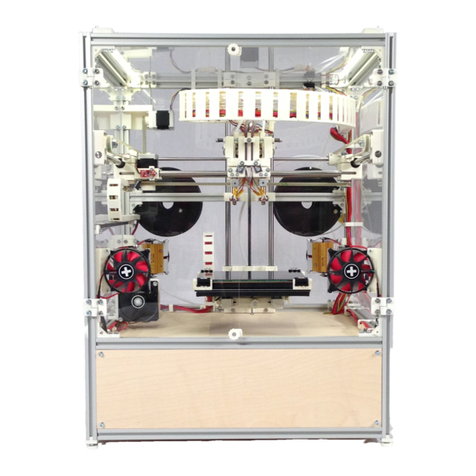application. It is not equipped with special
transport devices such as lifting eyes or handles.
The feet provide sufficient clearance to lift the
apparatus and carry it to the installation site.
While the HT500 is packed and on its transport
palette, use a lifting cart or pallet stacker for
transportation. Make sure that the weight is
evenly distributed and secure the HT500 against
tilting.
INFO
The housing is not designed for
subsequently attaching lifting eyes. If you
need to transport the 3D Printer longer
ways, load and secure it on a stable pallet
and transport it with a pallet stacker or
lifting cart.
Detailed information about safeguarding
and packing the 3D Printer for shipping can
be found in the Service Guide.
Storage
If the HT500 must be stored away, choose a leveled storage site and make sure that the 3D Printer
does not stand on a ledge.
Before storing it, clean the HT500 and protect it from dust with a plastic tarpaulin or air cushion foil.
NOTICE
Do not cover the 3D Printer with a textile sheet since the fibers may enter the supply system and clog
the nozzles after recommissioning. Use lint-free plastic sheets only.
The storage ambient conditions for the HT500 and its components are stated in the data sheet. For
recommissioning after lengthy periods of storage follow the information given in initial
commissioning.
Environment, recycling and disposal
When used as intended, the HT500 presents no environmental danger.
However, the internal cooling works with a coolant that can be environmentally dangerous when
leaking (see data sheet). Please observe the manufacturer's safety data sheet when handling the
coolant.
The materials used for printing can also be environmentally dangerous when handled improperly.
Always observe the manufacturer's safety data sheet and process plastics only within the limit values
specified therein and with respect to the safety instructions.
Generally, consider the environment: the auxiliary and operating materials of the HT500 can be
dangerous to environment and health.
Awareness and foresighted behavior help avoiding ecological and personnel damage.
Components may bear valuable elements such as rare earths, or may be reusable. Do not waste them
by inadequate and thoughtless disposal.
Environmentally hazardous substances must not trickle into the soil or enter the sanitation. They
must be stored in suitable containers and be disposed off adequately and in accordance with local
and national regulations.






























